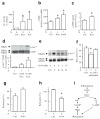Kynurenine is an endothelium-derived relaxing factor produced during inflammation
- PMID: 20190767
- PMCID: PMC3556275
- DOI: 10.1038/nm.2092
Kynurenine is an endothelium-derived relaxing factor produced during inflammation
Erratum in
- Nat Med. 2010 May;16(5):607
Abstract
Control of blood vessel tone is central to vascular homeostasis. Here we show that metabolism of tryptophan to kynurenine by indoleamine 2,3-dioxygenase (Ido) expressed in endothelial cells contributes to arterial vessel relaxation and the control of blood pressure. Infection of mice with malarial parasites (Plasmodium berghei) or induction of endotoxemia in mice led to endothelial expression of Ido, decreased plasma tryptophan concentration, increased kynurenine concentration and hypotension. Pharmacological inhibition of Ido increased blood pressure in systemically inflamed mice but not in mice deficient in Ido or interferon-gamma, which is required for Ido induction. Both tryptophan and kynurenine dilated preconstricted porcine coronary arteries; the dilating effect of tryptophan required the presence of active Ido and an intact endothelium, whereas the effect of kynurenine was endothelium independent. The arterial relaxation induced by kynurenine was mediated by activation of the adenylate and soluble guanylate cyclase pathways. Kynurenine administration decreased blood pressure in a dose-dependent manner in spontaneously hypertensive rats. Our results identify tryptophan metabolism by Ido as a new pathway contributing to the regulation of vascular tone.
Figures






Comment in
-
Ido brings down the pressure in systemic inflammation.Nat Med. 2010 Mar;16(3):265-7. doi: 10.1038/nm0310-265. Nat Med. 2010. PMID: 20208509 No abstract available.
Similar articles
-
Ido brings down the pressure in systemic inflammation.Nat Med. 2010 Mar;16(3):265-7. doi: 10.1038/nm0310-265. Nat Med. 2010. PMID: 20208509 No abstract available.
-
Tryptophan metabolism to kynurenine is a potential novel contributor to hypotension in human sepsis.Crit Care Med. 2011 Dec;39(12):2678-83. doi: 10.1097/CCM.0b013e31822827f2. Crit Care Med. 2011. PMID: 21765346
-
Indoleamine 2,3 dioxygenase-mediated tryptophan catabolism regulates accumulation of Th1/Th17 cells in the joint in collagen-induced arthritis.Arthritis Rheum. 2009 May;60(5):1342-51. doi: 10.1002/art.24446. Arthritis Rheum. 2009. PMID: 19404944
-
Relationship between interferon-gamma, indoleamine 2,3-dioxygenase, and tryptophan catabolism.FASEB J. 1991 Aug;5(11):2516-22. FASEB J. 1991. PMID: 1907934 Review.
-
The new '5-HT' hypothesis of depression: cell-mediated immune activation induces indoleamine 2,3-dioxygenase, which leads to lower plasma tryptophan and an increased synthesis of detrimental tryptophan catabolites (TRYCATs), both of which contribute to the onset of depression.Prog Neuropsychopharmacol Biol Psychiatry. 2011 Apr 29;35(3):702-21. doi: 10.1016/j.pnpbp.2010.12.017. Epub 2010 Dec 23. Prog Neuropsychopharmacol Biol Psychiatry. 2011. PMID: 21185346 Review.
Cited by
-
Calcium desensitisation in late polymicrobial sepsis is associated with loss of vasopressor sensitivity in a murine model.Intensive Care Med Exp. 2015 Dec;3(1):36. doi: 10.1186/s40635-014-0036-8. Epub 2015 Jan 31. Intensive Care Med Exp. 2015. PMID: 26215803 Free PMC article.
-
Maternal Inflammation Disrupts Fetal Neurodevelopment via Increased Placental Output of Serotonin to the Fetal Brain.J Neurosci. 2016 Jun 1;36(22):6041-9. doi: 10.1523/JNEUROSCI.2534-15.2016. J Neurosci. 2016. PMID: 27251625 Free PMC article.
-
Tryptophan-kynurenine pathway is dysregulated in inflammation, and immune activation.Front Biosci (Landmark Ed). 2015 Jun 1;20(7):1116-43. doi: 10.2741/4363. Front Biosci (Landmark Ed). 2015. PMID: 25961549 Free PMC article. Review.
-
M. tuberculosis induces potent activation of IDO-1, but this is not essential for the immunological control of infection.PLoS One. 2012;7(5):e37314. doi: 10.1371/journal.pone.0037314. Epub 2012 May 23. PLoS One. 2012. PMID: 22649518 Free PMC article.
-
Kynurenines in the mammalian brain: when physiology meets pathology.Nat Rev Neurosci. 2012 Jul;13(7):465-77. doi: 10.1038/nrn3257. Nat Rev Neurosci. 2012. PMID: 22678511 Free PMC article. Review.
References
-
- Riedemann NC, Guo RF, Ward PA. Novel strategies for the treatment of sepsis. Nature Medicine. 2003;9:517–523. - PubMed
-
- Gomez-Jimenez J, et al. L-arginine: nitric oxide pathway in endotoxemia and human septic shock. Crit Care Med. 1995;23:253–258. - PubMed
-
- Ignarro LJ, Cirino G, Casini A, Napoli C. Nitric oxide as a signaling molecule in the vascular system: an overview. J Cardiovasc Pharmacol. 1999;34:879–886. - PubMed
-
- Meyer J, et al. Reversal of hyperdynamic response to continuous endotoxin administration by inhibition of NO synthesis. J Appl Physiol. 1992;73:324–328. - PubMed
Publication types
MeSH terms
Substances
Grants and funding
LinkOut - more resources
Full Text Sources
Other Literature Sources
Molecular Biology Databases
Research Materials

